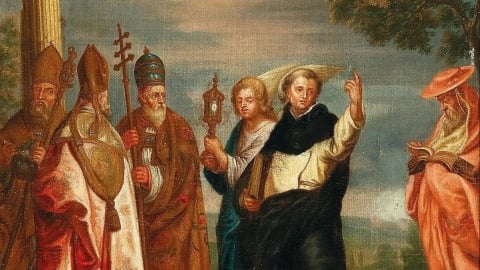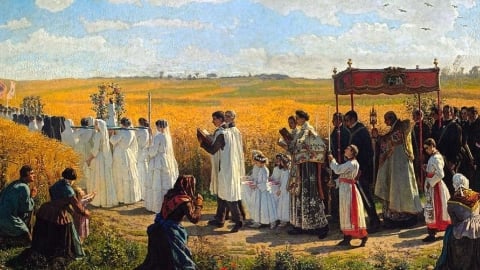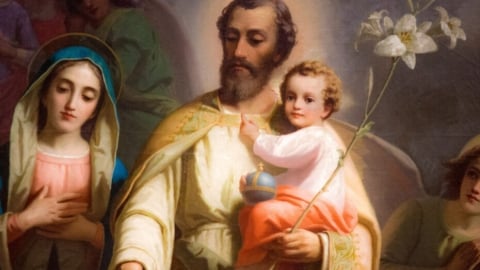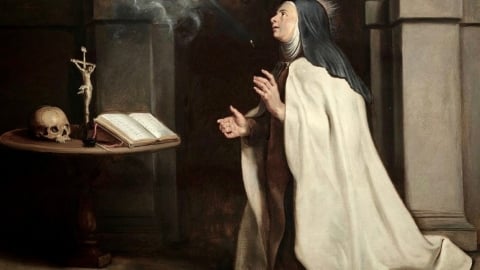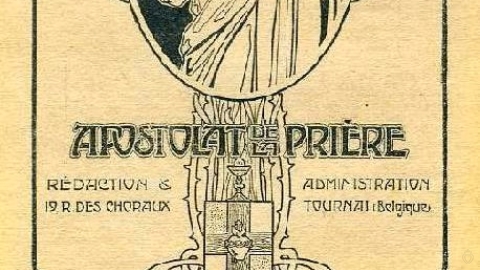Father Roger-Thomas Calmel, O.P.

This year marks the 40th anniversary of the death of Father Roger Thomas Calmel (1914-1975), a worthy son of Saint Dominic, an intrepid defender of the Faith, the Mass, and the priesthood in times of trial. Here are some lines to present the figure of this priest who reacted similarly to Archbishop Marcel Lefebvre, having nurtured in his soul the same love for the Mass, the Magisterium of the Church, and the pure and uncontaminated doctrine of Saint Thomas Aquinas.
1st Birth and Vocation, 1914-1933.
Roger Calmel was born on May 11, 1914, on the family farm in Sauveterre-la-Lémance. His admirable Christian parents raised their four children in the worship of goodness and truth, of the beautiful and the just, combining the peasant wisdom of the land with the higher wisdom of the Cross, creating a home atmosphere of fervor, joy, and prudence.
In this atmosphere, the vocation of young Roger Calmel awakened. In 1926, he entered the minor seminary of Agen. There, he devoted himself to study with ardor and diligence, according to his former classmates. While studying, he desired a closer union with the Lord, as evidenced by the "contract of love" he made with his "good Mother," the Immaculate Virgin, in 1930 at the age of 15, after donning the cassock:
"I consecrate to you my heart, my body, and my soul; I entrust to you my vocation, my interests in time and eternity. [...] Give me your holy and maternal blessing every day until the last day when your Immaculate Heart will present me in heaven to the Heart of Jesus, to love and bless you endlessly."
In 1933, his superiors sent him to the Catholic Institute of Toulouse, recently founded, to continue his studies. In an era when liberalism and modernism infiltrated the Church, the young seminarian engaged in a deeper and more flavorful contemplation of divine mysteries, guided by the Angelic Doctor, to whom he remained faithful until the end of his days.
2nd In the Militia of Saint Dominic, 1936-1946.
It was not only his admiration for the thought of Saint Thomas Aquinas that led him to seek admission to the Order of Preachers in 1936, but also the consonance of this vocation with his sense of priesthood and love for truth. Truth contemplated in prayer and study and communicated to souls through preaching: Contemplari et contemplata aliis tradere. Clad in the white habit of Saint Dominic, the young novice was sent to the study convent of the Province of Toulouse. There, he could draw from the source the spirit of his Order and be shaped by the ideal of Saint Dominic, whom he admired as a man of prayer and a priest of God.
This extraordinary man - as he would be described - had an exceptional love for Jesus Christ, a sense of the Church's need in the 13th century, a sense of the value of souls, and the danger of eternal condemnation posed by the plague of heresy: "Quid fient peccatores?" With these dispositions, he made his first profession on November 1, 1937, his solemn profession on November 1, 1940, and received priestly ordination on March 29, 1941, Sitientes Saturday. On the occasion of his ordination, he providentially came into contact with the Dominican Sisters of the Holy Name of Jesus, especially with the prioress of the Toulon community, Mother Hélène Jamet, who willingly agreed to host the newly ordained and his family for the meal that followed the ceremony. The Mother did not suspect the role the young Dominican would play in the Congregation from 1945 to 1975, nor the supernatural bonds that would unite him with the Sisters.
At the end of 1941, he was sent to Toulouse and then to Marseille to take charge of oral preaching in parishes and schools, retreats and pilgrimages, and written preaching through his collaboration with two magazines, La Vie Dominicaine and La Revue Thomiste.
3rd With the Dominicans of the Holy Name of Jesus, 1946-1956.
In 1946, Father Calmel returned to Toulouse. As the Fathers' convent was near the Motherhouse of the Sisters of the Holy Name of Jesus, Father was requested to provide his priestly ministry to the Sisters and novices, and the students they were responsible for. He soon manifested himself as an experienced guide in the paths of union with God. Also during this time (1951-1952), he worked with Mother Hélène Jamet, then the Superior General, on the reform of the Constitutions of their Congregation, aiming to unify the Sisters' life as Dominican teaching religious and adapt it to their mission as "mothers of souls, consecrated to the Lord for a mission of Christian educators."
The new text of the Constitutions, completed in November 1952, received approval from the Sacred Congregation of Religious in August 1953. However, in 1954, Father received a prohibition from his superiors to continue this fruitful apostolate, which was already considered too traditional, and was then separated from the Dominicans. Later, in 1956, he was sent to Spain, where he used his exile to meditate on the doctrine and life of Saint John of the Cross and Saint Teresa of Jesus and to discover the flourishing Dominican convents in Spain at that time.
4th Son of the Church in Times of Trial, 1957-1974.
In 1957, Father Calmel returned to France, being assigned to various places and wearing himself out everywhere, perceptive of the dangers of these years of political, social, moral, and spiritual crisis.
Indeed, the Second Vatican Council, convened by Pope John XXIII in 1962, would soon make its disastrous effects felt and impose its revolutionary spirit. The first thing Father Calmel would criticize was the ambiguous language adopted in its documents, "vague, slippery expressions that can be interpreted in all senses, and to which everyone attributes the meaning they want," causing in him reactions of perplexity, indignation, and pain. Therefore, his main weapon, in line with the spirit of the Church, would be clear and unambiguous language, referring to the infallible and irreformable definitions of the Magisterium.
Hence, his tireless work as a preacher through the pen, becoming a frequent collaborator with the magazine "Itineraires" from 1958 to 1975 and publishing numerous doctrinal books, including "Theology of History," "Brief Apology for the Church of Always," "The Mysteries of the Kingdom of Grace," and "The Greatness of Jesus Christ."
The same applied to the rites of the liturgy and the formulas of the sacraments, which, for their efficacy and validity, must accurately and precisely convey the Church's intention. However, in 1969, through the apostolic constitution Missale Romanum, Pope Paul VI imposed a Novus Ordo Missae, a versatile Mass, "whose radical flaw," he declared in 1970, "is to have introduced into the celebration of the Mass the system of optional, often vague, rites and formulas that give legal credentials to the celebration of both the true Mass and the heretical 'memorial.'"
His response to this imposture was swift: his "Declaration," a protest of absolute fidelity to the Mass of his ordination, written on November 27, 1969, three days before the Novus Ordo came into effect. Eager to enlighten, strengthen, and comfort the abandoned souls facing the advances of secularism, doctrinal ambiguities, moral decline, liturgical revolutions, and the abandonment of shepherds, he did not hesitate to respond to their call.
"Some laypeople," he said, "in the present darkness, refuse to be deceived; they realize that the devil wants to tie and demolish the Church, and they are determined to fight. But they cannot find any priest who has avoided the progressive current, or at least has the courage and strength to confront it. When they discover one, they feel reassured and willing to listen." And he concluded with frankness and simplicity: "I believe I am one of these priests. That's why I will try not to disappoint their hopes."
With delicacy and invincible patience, with firmness and kindness simultaneously, he encouraged, admonished, blessed, and advised. With great realism, he advocated for the establishment of small bastions of Christendom: communities, schools, families, publications, each becoming a bastion of holiness. This same realism led him to aspire with all his might to the public intervention of a bishop who would reassure perplexed Catholics: Archbishop Lefebvre, whom Father Calmel met for the first time in Toulon on August 15, 1970.
The firmness of his positions earned him numerous sufferings: in addition to the trials due to his fragile health, he had to endure numerous condemnations and sanctions from certain Roman authorities, distrust or misunderstandings within his beloved Order, and what he called "sociological relegation." And what can be said of his pain at the betrayal of pastors and consecrated souls, the abandonment of his brothers in arms, and the distress of the faithful? All these trials, however, helped him grow in love and silence. Because his struggle was not violent. It was not about fighting for the sake of fighting, nor to defend personal positions, but to defend the truth and the rights of God.
"Pray," he said to the faithful. "May prayer keep you steadfast in God's infinite love and make you so united to Him that you can taste peace beyond all discussion. [...] Only prayer comforts and pacifies us, urging us to give our lives, each in their place and in the way God determines, for the good of the chosen ones. Only prayer makes us remain, in silence and love, in the glorious wounds of Jesus Crucified."
5th Illuminate and Disappear into the Light, 1974-1975.
With the permission of his superiors, Father Calmel spent the last months of his earthly life in Saint-Pré (Brignoles) – currently the Motherhouse of a traditional branch of the Sisters of the Holy Name of Jesus, to which the Dominicans of Anisacate and La Reja belong – where these Sisters had transferred the Santo Domingo school from Toulon. Father Calmel had encouraged them to remain faithful to the traditional Mass and liturgy, the Dominican religious state, and the Thomistic conception of the school, being a luminous and reliable guide for them until the end.
He left this life on May 3, 1975, the day the Church celebrated the Finding of the Holy Cross, and was buried in the Sisters' cemetery two days later, on May 5, 1975, the feast of Saint Pius V.
As he had said himself, he wanted to illuminate and disappear into the light. He flew to his homeland, completely absorbed in the truth, beauty, and simplicity of God, and fascinated by His light. But the light he left us still continues to shine.
Source : Hojitas de Fe | FSSPX
